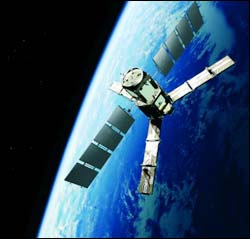ESA and EADS-CASA sign contract to build instrument for the SMOS mission

The Soil Moisture and Ocean Salinity mission will provide global maps of soil moisture and ocean salinity. Soil moisture data are urgently required for hydrological studies and data on ocean salinity are vital for improving our undertanding of ocean circulation patterns. Together these data will contribute to furthering our knowledge of the Earth’s water cycle, and will improve climate, weather and extreme-event forecasting.
A significant milestone in the development of ESA’s Soil Moisture and Ocean Salinity (SMOS) mission was reached last week when the contract to build the payload was signed between ESA and EADS (European Aeronautic Defence and Space Company)-CASA from Spain.
The contract, worth 62 million euros, was signed in Madrid, Spain on 11 June 2004 at the premises of the CDTI (Centre for Development of Industrial Technology). EADS-CASA now heads an industrial consortium of more than 20 companies from all over Europe, and is committed to construct the innovative MIRAS (Microwave Imaging Radiometer using Aperture Synthesis) instrument that will form the core of the SMOS mission.
Scheduled for launch in early 2007, SMOS is the second Earth Explorer Opportunity mission to be implemented as part of ESA’s Living Planet Programme. The main aim of the mission is to further the development of climatological, meteorological and hydrological models by observing soil moisture over the Earth’s landmasses and sea-surface salinity over the oceans for a period of at least 3 years. At the signing ceremony, Prof. José Achache, ESA’s Director of Earth Observation Programmes, stated that, “SMOS will provide a major advancement in our ability to model and understand the global hydrological cycle.”
The moisture in soil and the salt in the oceans are intrinsically linked to the Earth’s water cycle and climate. Currently, in-situ measurements for soil moisture are sparse, but if we are to better understand the water cycle so that the forecasting of climate, weather and extreme events such as floods can be improved more data are urgently required. The same is true for data on ocean salinity – only a small fraction of the ocean is sampled on any regular basis. However, salinity is an important factor driving the currents in the ocean and in turn ocean circulation plays a crucial role moderating the climate. Therefore, comprehensive data on ocean salinity would greatly improve our knowledge of the conditions that influence global ocean circulation and thus climate.
Not only will this mission further our understanding of the Earth system, but it will also demonstrate a new measuring technique by adopting a completely different approach in the field of remote sensing. SMOS will carry the first-ever polar-orbiting satellite-borne
2-D interferometric radiometer. From an altitude of 763 km, the novel MIRAS instrument has been designed to capture images of microwave radiation emitted from the surface of the Earth at L-band (1.4 GHz).
MIRAS is made up of a central structure and three deployable arms. There are 69 antenna elements, so-called LICEF receivers, which are equally distributed over the central structure and three arms. Each LICEF is an antenna-receiver integrated unit that measures the radiation emitted from the Earth at L-band. The measuring principle takes advantage of the fact that moisture and salinity influence the emissivity of soil and seawater, respectively. From the information gathered, scientists will be able to derive maps of soil moisture and ocean salinity on a global scale.
Now that the contract has been signed to go ahead and build the payload the SMOS mission has taken a significant and exciting step forward in its development.
Media Contact
More Information:
http://www.esa.int/esaSA/SEMLY93VQUD_earth_0.htmlAll latest news from the category: Physics and Astronomy
This area deals with the fundamental laws and building blocks of nature and how they interact, the properties and the behavior of matter, and research into space and time and their structures.
innovations-report provides in-depth reports and articles on subjects such as astrophysics, laser technologies, nuclear, quantum, particle and solid-state physics, nanotechnologies, planetary research and findings (Mars, Venus) and developments related to the Hubble Telescope.
Newest articles

Innovative 3D printed scaffolds offer new hope for bone healing
Researchers at the Institute for Bioengineering of Catalonia have developed novel 3D printed PLA-CaP scaffolds that promote blood vessel formation, ensuring better healing and regeneration of bone tissue. Bone is…

The surprising role of gut infection in Alzheimer’s disease
ASU- and Banner Alzheimer’s Institute-led study implicates link between a common virus and the disease, which travels from the gut to the brain and may be a target for antiviral…

Molecular gardening: New enzymes discovered for protein modification pruning
How deubiquitinases USP53 and USP54 cleave long polyubiquitin chains and how the former is linked to liver disease in children. Deubiquitinases (DUBs) are enzymes used by cells to trim protein…


